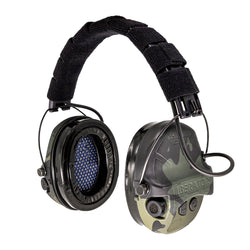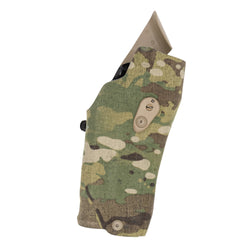There is a lot of opinion to choose from when buying a handgun like caliber, size, gun accessories, holster, etc. But regardless of the choice you make in each category, there are five steps that can help you along the way. Not so much as a “what” to buy, but other considerations you should take to help make the choices a little easier.
You see, a decision on a handgun will impact what light or optic will work with it. And then the holster you choose will need to be compatible with the gun and accessories you plan to put on the gun.
And there is the big question of how you plan to carry that gun and whether or not you want to use an IWB or OWB holster.

All these things are tied together and deciding some things before you purchase a gun is important. But even if you have already purchased a new gun, going over these five steps is still beneficial before you start buying anything for that gun.
One of my first experiences with purchasing a new handgun was a disaster. I found a gun that looked cool and bought it. Then I decided to find a holster. That was also a hard task for me because I didn’t know what I was doing at the time.
Once I bought the holster, I purchased a light for my handgun, and then realized the light should have been picked out before the holster. I made the same mistake with other accessories, ammunition, etc.
So, if you plan to or have already purchased a new gun, here are some things to consider.
1. Select accessories for your new handgun
Accessories are like toppings on a pizza. They make the difference between basic and fully loaded. But unlike extra pepperoni, picking an assortment of accessories will impact everything else with your gun.
When I bought my first AR-15, it had a stock rifle with a full-length picatinny rail. After purchasing it, I spent a month trying out different accessories on it. For an AR-15 that works great. But handguns are a little different. For example, some handguns have longer rails than others, and some don’t have any rails at all. So, you may want to do some research and make some decisions before doing anything else. Consider the following accessories;
Lights
Do you want to use a light, and if so, which one? Make sure your gun will accommodate the light you want to use. The Glock 19, for example, will work with a full-size WML (weapon-mounted light) like the Nightstick TWM-30. But you can also use the TCM-10 or other compact WML with a Glock 19. Some compact handguns, however, are too small to mount the TWM-30 and require a compact light of a certain size.
It’s important to choose the light early on because the holster you select will need to accommodate the specific light you purchase.

Optics
Are you going to mount an optic on your handgun? If so, the gun will need to have a removable optics plate. Most newer guns nowadays come with removable optics plates, but not all of them do.
Besides the removable plate, you also want to check and see what footprint is required for mounting an optic to the slide of that gun. Numerous footprints are being used, and this will determine what optics you can use for that handgun.
I wish there were one universal footprint so all optics would work on all handguns, but that’s not the case. For more information about optic footprints, check out my “Guide To Red Dot Footprints article”.
Other upgrades
What other changes do you want to make to your handgun? This could be a magazine extension, extended slide release, threaded barrel, high-rise sights, etc.
Some optics will block your view of the iron sights that come with the gun. Other optics have grooves cut in them so you can still see your iron sights through the optic window.

Another reason to use upgraded sights is to accommodate a silencer. Silencers are becoming more and more popular as people are seeing the benefits of using one. Suppressor height sights are needed unless you have an optic mounted on your gun.
Once you have all the accessories figured out for your handgun, you can start looking at holster setups.
2. Select a Quality Holster
Holsters today are much different than holsters of the past. A good-quality, molded holster will give your gun a precise fit.
I remember when holsters used to be made for small, medium, or large handguns. But the guns wobbled around in the holster and often did not fit well. Now, holsters are made to fit like a glove, which requires finding a holster for that specific gun.
For example, when using Safariland’s holster finder, you will be asked to select your gun and then whether or not you use a light or optic. If you answer yes to either of those, it will ask you to select a specific light and optic you use. This applies to duty holsters, concealable OWB holsters, and IWB holsters.
The reason you want a precise fitting holster is because of the safety it provides to you and others around you. A holster is more than a pouch, it’s your gun’s home.
How do you plan to carry your handgun?
Another thing to consider when selecting a gun, accessories, or holster is how you plan to carry that gun.
If your dream is to dress like G.I. Joe and run through the woods half naked wearing your battle belt and gun, you may want a different setup than one for carrying concealed.

For concealed carry, a compact gun with compact accessories and an IWB holster is a great choice. Your choice will help you determine what gun, accessories, and holster you want.
Once you have made up your mind on the gun, accessories, and type of carry, do some homework. Check to make sure a holster is available before you put all that money into setting up your gun.
3. Purchase Training and Defensive Ammunition
Ammo selection is kind of a big deal, especially for some handguns. After all, your gun’s only purpose is to send rounds downrange, so you need the right ones.
Years ago, I purchased a handgun that had just been released to the market. It was a 9mm, so I loaded up on some cheap 9mm and headed to the range. I was disappointed to see the gun malfunction constantly.
After doing some research, I realized this gun did better with 124 and 147 grain ammo. One more trip to the range with the new ammo and presto, not a single issue with the gun. I could have saved myself some time if I had just done a little research before purchasing the gun and/or ammo. The point is, some guns shoot some ammo better than others, and some guns will handle anything.

Another example of this is 1911 handguns. Technology has really helped with this, but a lot of mil-spec 1911 handguns struggle shooting some types of hollow point ammunition. This is because the feed ramp is very steep in a 1911, and some HP ammo hits it head-on like a brick wall.
Don’t get me wrong, I love 1911 handguns, and they are very reliable. But you have to make sure you know it will work with the ammo you’re shooting.
Should you break in your gun?
If your gun is new, put some ammo through it to ensure it functions properly. Some call this the break-in period. A good rule of thumb is to shoot at least 500 rounds of target ammo, and 50 rounds of your chosen defensive ammo.
If you do this and have no issues, it’s a good sign your gun is reliable. This is especially important for any gun you plan to carry for self-defense.
Beware of ammo prices before you select your gun
Another important thing to consider when selecting a handgun is the price of ammunition for that caliber. I have heard people say they are not worried about an expensive caliber because they are “only using it for self-defense.” That translates to “I don’t plan on shooting it much.”

However, it’s vital that you plan to train with your gun regularly. Run some drills, make sure you are comfortable shooting, and your handgun remains in pristine condition.
Even if your chosen handgun is a small micro-compact pistol that is not fun to shoot, you should plan to train with it at the range if you plan to carry it. And that means buying ammo.
4. Train with Your New Setup
Buying and setting up a handgun is like buying a car, it doesn’t do you much good if you don’t know how to use it properly.
As I mentioned above, training with your handgun, holster, and chosen accessories is kind of important. It’s not just about shooting accurately; it’s about building confidence, muscle memory, and safe habits.
Start with the basics: proper grip, stance, and trigger control. Dry fire practice (with an unloaded gun!) can help you develop muscle memory without burning through ammo. Once you’re comfortable, move to live fire.

Practice drawing from your holster and engaging targets under various conditions that require the use of any accessories on your gun.
Don’t forget to train with your defensive ammo, too. The recoil and performance may differ from training rounds, so it’s important to get used to how your gun handles the ammunition.
Consider professional training courses. A reputable instructor can teach you advanced skills, like shooting on the move, using cover, and defensive tactics. Even experienced shooters benefit from ongoing training because there’s always room for improvement, right?.
Finally, make sure you’re comfortable with your setup. If something doesn’t feel right, fix it. A holster that pinches or a light that’s hard to activate may require some adjustments or changes. The goal is a system that feels natural and intuitive.
5. Consider Purchasing CCW Insurance
Once your gun, gear, and ammo are ready to go and training is part of your routine, there is one thing left to consider. This is liability insurance for those who carry.
Nobody buys a gun hoping to use it in self-defense, but life doesn’t always go as planned. If the unthinkable happens and you must defend yourself, having concealed carry (CCW) insurance can save you from financial ruin.
CCW insurance helps cover the legal costs of a self-defense incident, including attorney fees, court costs, and even civil lawsuits. In today’s litigious society, you can be sued for anything, even in a self-defense situation that is ruled justified. Having insurance gives you peace of mind that you’re financially protected.
When shopping for a policy, look for coverage that includes criminal defense, civil liability, and bail bond funding. Some policies also provide training resources and 24/7 access to legal advice. Companies like USCCA, NRA Carry Guard, and Armed Citizens’ Legal Defense Network offer various plans.
Like any insurance, you hope you’ll never need it. But if you do, it’s better to have it and not need it than to need it and not have it.
Are you ready to set up your handgun?
Buying a handgun is just the first step in a larger journey. My hope is that these five steps will help you along your journey to setting up your handgun. I had to learn from my own mistakes along the way, but maybe we can all learn from them together.
Remember, owning a gun is a serious responsibility, but it doesn’t have to be overwhelming. Take it one step at a time, and don’t forget to enjoy the process. After all, shooting is supposed to be fun, and maybe even a little therapeutic.
Stay safe, train hard, and keep those Negative Nancys at bay with your newfound confidence.











